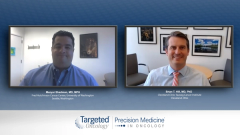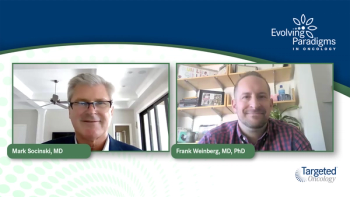
Treatment Methods: Transplant Eligibility in R/R DLBCL and CAR T Cell Therapy
The experts delve further into treatment methods for relapsed/refractory diffuse large B-cell lymphoma, particular for transplant-eligible and -ineligible patients.
Episodes in this series

Mazyar Shadman, MD, MPH: In the past 2 years, we’ve had access to a number of new treatment agents or modalities, and I just wonder what your standard practice is. We are waiting for some of the recently announced press releases from some head-to-head trials comparing standard of care to CAR [chimeric antigen receptor] T-cell therapy, but at the moment at least we don’t have any details of those studies. Our standard approach would be to use a second-line chemotherapy, a platinum-based therapy, to achieve a complete remission or maybe a good partial remission as we move with autologous stem cell transplant. There are, of course, patients who are not eligible for a stem cell transplant. I was wondering what your approach is in general in the relapse setting, and then also for patients who are not eligible for a transplant?
Brian T. Hill, MD, PhD: It’s a very similar approach. The standard across the United States and internationally is still to take patients who relapse from, let’s say, R-CHOP [rituximab, cyclophosphamide, hydroxydaunorubicin hydrochloride, vincristine, prednisone] or similar frontline therapy with diffuse large B-cell lymphoma and try to get them into a remission, which will last hopefully for a very long time. The platinum-based chemotherapies that are typically used as second-line regimens, such as R-ICE [rituximab, ifosfamide, carboplatin, etoposide] or R-DHAP [rituximab, dexamethasone, cytarabine, cisplatin] are generally effective at doing this. Once you get into remission, then consolidation with high doses of chemotherapy and autologous stem cell rescue is the standard approach. But we know, unfortunately, that not everyone who needs a transplant gets there, and there are a few reasons why. One of the most common is not even being referred for 1 because you have to go to a transplant center. The other common thing we see, unfortunately, is that people in relapse, when treated with, let’s say, R-ICE [rituximab, ifosfamide, carboplatin] or a similar chemotherapy, don’t respond well. It’s easy if they get a complete remission to move on to transplant, but many patients don’t. Overall, the complete remission rate with platinum-based chemotherapy has been reported somewhere in the 30%-to-40% range, with overall response rates in the 50%-to-60% range. Has that been your experience too? Do you see a lot of patients who don’t respond to salvage treatment, as we call it?
Mazyar Shadman, MD, MPH: Yes, we do, and the success rate to get to stem cell transplant in terms of being responsive to next lines of chemotherapy is around 50%, and then looking at an overall cure rate in this setting beyond the first line of around 20% to 30%. Not being transplant eligible happens for 2 reasons, as we talked about. To give somebody a high-dose chemotherapy, they have to show you that they’re sensitive to chemotherapy. But I wonder about the criteria for calling somebody transplant ineligible, mainly for comorbidities or age and factors like that. We’re both coming from large transplant centers. It’s difficult for us to send somebody back for transplant, but it happens. This is a moving target. The risk-benefit assessment changes as you have alternative options. Two years ago I had no option. I may have accepted a patient for transplant with a few more comorbidities. With the treatments that we’ll be discussing, that assessment is different. Is that your experience? Is that what you’ve seen? In general, what kind of patient do you not consider transplant eligible from a comorbidity standpoint?
Brian T. Hill, MD, PhD: You need to have a certain level of organ fitness and functional status, but you’re right that probably the biggest determinant of what we deem to be transplant eligible is their sensitivity to the chemotherapy. The reason why fewer transplants are being done, and we’ve seen that in national databases, is that if you’re not in a complete remission after second-line treatment, you used to not have any options. But now we know even for people who have relapsed after transplant or if they’re not in a good remission going into transplant, we have CAR T-cell treatment as an option.
Maybe we should mention for the audience what CAR T-cell treatment is. Many people are familiar that you can collect patients’ T cells from the peripheral blood and have them manufactured, genetically engineered to express chimeric antigen receptor, that redirects them to target CD19, which is present in all B cells. After a brief period of lymphodepletion, if the cells are readministered to the patient, they have significant antitumor effects and tumor kill, which can lead to responses and even complete remission in patients who were refractory to prior chemotherapy. From that perspective, we have these options for patients who might have been previously considered transplant eligible. Transplant may not be their best option and maybe we should go straight to CAR T-cell therapy.
This transcript has been edited for clarity.










































